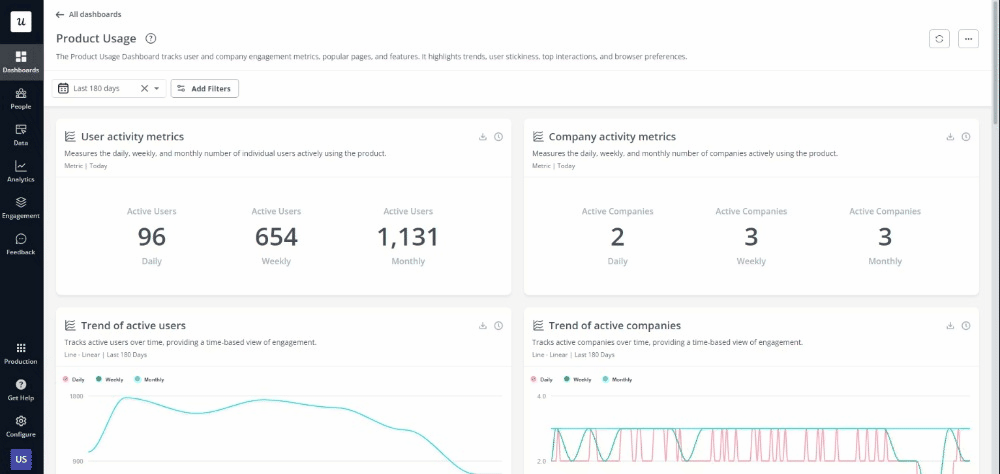
Product trainer’s main responsibilities
Product trainers play a crucial role in ensuring that employees, customers, or partners understand and effectively use a company’s products or services. Their responsibilities are diverse and can vary depending on the industry, company size, and product complexity. However, here are some core duties:
- Design and develop training materials, including presentations, workshops, webinars, e-learning modules, and hands-on exercises.
- Deliver engaging and informative training sessions tailored to different audiences and learning styles (i.e. onboarding new employees and customers on product usage).
- Troubleshooting technical issues and providing product support.
- Stay up-to-date on product updates, new releases, and industry trends.
- Gather feedback from trainees and stakeholders to assess training needs and identify areas for improvement.
Try Userpilot Now
See Why 1,000+ Teams Choose Userpilot

Product trainer job description and template
To help you better understand what companies often look for in product trainer roles, here’s a product trainer job description template based on real job postings:
Job Title: Product Trainer
Department: Training/Customer Success/Sales Enablement
Reports To: Training Manager/Director of Customer Success
Summary:
We are seeking a dynamic and knowledgeable Product Trainer to develop and deliver comprehensive training programs on our products and services. You will empower our customers, employees, and partners to maximize their understanding and utilization of our offerings. The ideal candidate will have a passion for teaching, a deep understanding of our products, and the ability to create engaging learning experiences.
Responsibilities:
- Curriculum Development: Design, develop, and maintain up-to-date training materials, including presentations, workshops, webinars, e-learning modules, and user guides.
- Training Delivery: Conduct engaging training sessions for diverse audiences, including new hires, existing employees, customers, and partners.
- Needs Assessment: Analyze training needs and identify knowledge gaps to tailor training programs for maximum impact.
- Evaluation: Assess the effectiveness of training initiatives through feedback surveys, quizzes, and performance metrics.
- Product Expertise: Stay abreast of new product releases, features, and updates, incorporating them into training materials and sessions.
- Collaboration: Partner with cross-functional teams (e.g., product management, sales, marketing) to ensure alignment between training content and business objectives.
Qualifications:
- Education: Bachelor’s degree in a relevant field (e.g., education, business, technology) or equivalent experience.
- Experience: 2+ years of experience in product training, instructional design, or a related role.
- Product Knowledge: Proven expertise in our industry and a strong understanding of our products and services.
- Communication Skills: Excellent verbal and written communication skills with the ability to present complex information clearly and concisely.
- Training Expertise: Experience with various training methodologies (classroom, virtual, e-learning) and instructional design principles.
- Technical Skills: Proficiency in Microsoft Office Suite, Learning Management Systems (LMS), and other relevant training tools.
Additional Skills (Preferred):
- Certification: Certified Professional in Training Management (CPTM) or similar credentials.
- Sales Enablement: Experience in sales training or enablement programs.
- Customer Success: Background in customer success or support roles.
Compensation and Benefits:
- Competitive salary and benefits package.
- Opportunities for professional development and growth.
- A collaborative and supportive work environment.
To Apply:
Please submit your resume, cover letter, and a portfolio of relevant training materials.
Best practices to be a great product trainer
Becoming a great product trainer requires a mix of expertise, empathy, and effective communication. Here are some best practices to help you excel in this role:
- Start with the “Why”: Begin by explaining the value proposition of the product. Why should learners care? How will it help them or their organization? This sets the context and motivates them to learn.
- Cater to Different Learning Styles: Don’t just lecture. Incorporate a variety of teaching methods like demos, interactive guidance, gamifications, and quizzes to appeal to different learning styles.
- Provide Real-World Context: Use case studies, examples, and scenarios to show how the product is used in real-world situations. This helps learners connect the dots and see the practical applications of what they’re learning.
- Offer Ongoing Support: Don’t just end the training with a Q&A session. Provide resources like documentation, FAQs, or a community forum where learners can get ongoing support and answers to their questions.
- Gather Feedback and Iterate: Regularly collect feedback from learners to evaluate the effectiveness of your training. For example, you can send a post-onboarding survey to measure user satisfaction. Use this feedback to refine your materials, delivery, and overall approach.
- Stay Updated on Product Changes: Products evolve constantly. Make sure your training materials are always up-to-date and reflect the latest features and functionalities.
Product trainer FAQs
What is the role of a product trainer?
A product trainer is a professional responsible for educating and empowering individuals on the effective use of a company’s products or services. They play a crucial role in ensuring that customers, employees, or partners understand the features, benefits, and best practices associated with the product.
What is a product trainee?
A product trainee is an individual who is undergoing training to become a product trainer. They are typically new to the role and are learning the necessary skills and knowledge to develop and deliver effective training programs.
What is a technical product trainer?
A technical product trainer specializes in educating users on the technical aspects of a product or service. They possess a deep understanding of the product’s technology and functionality. Their training sessions often involve in-depth demonstrations, hands-on exercises, and troubleshooting technical issues.
Conclusion
We hope this guide has provided you with valuable insights into the roles and responsibilities of product trainers.
By understanding the key responsibilities and skills required, you can make informed decisions and take meaningful steps in your career or recruitment journey.
Looking into tools for product trainers? Userpilot is an all-in-one product platform with engagement features and powerful analytics capabilities. Book a demo to see it in action!








